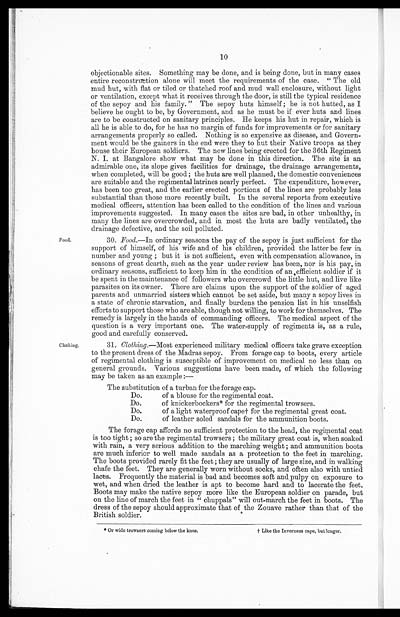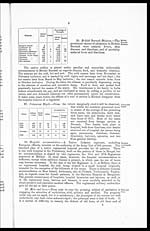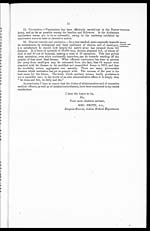Medicine - Institutions > Army health reports and medical documents > Medical and sanitary reports of the native army of Madras > Medical and sanitary report of the native army of Madras for the year 1876
(19) Page 10
Download files
Individual page:
Thumbnail gallery: Grid view | List view

10
objectionable sites. Something may be done, and is being done, but in many cases
entire reconstruction alone will meet the requirements of the case. " The old
mud hut, with flat or tiled or thatched roof and mud wall enclosure, without light
or ventilation, except what it receives through the door, is still the typical residence
of the sepoy and his family. " The sepoy huts himself; he is not hutted, as I
believe he ought to be, by Government, and as he must be if ever huts and lines
are to be constructed on sanitary principles. He keeps his hut in repair, which is
all he is able to do, for he has no margin of funds for improvements or for sanitary
arrangements properly so called. Nothing is so expensive as disease, and Govern-
-ment would be the gainers in the end were they to hut their Native troops as they
house their European soldiers. The new lines being erected for the 36th Regiment
N. I. at Bangalore show what may be done in this direction. The site is an
admirable one, its slope gives facilities for drainage, the drainage arrangements,
when completed, will be good; the huts are well planned, the domestic conveniences
are suitable and the regimental latrines nearly perfect. The expenditure, however,
has been too great, and the earlier erected portions of the lines are probably less
substantial than those more recently built. In the several reports from executive
medical officers, attention has been called to the condition of the lines and various
improvements suggested. In many cases the sites are bad, in other unhealthy, in
many the lines are overcrowded, and in most the huts are badly ventilated, the
drainage defective, and the soil polluted.
Food.
30.Food.— In ordinary seasons the pay of the sepoy is just sufficient for the
support of himself, of his wife and of his children, provided the latter be few in
number and young; but it is not sufficient, even with compensation allowance, in
seasons of great dearth, such as the year under review has been, nor is his pay, in
ordinary seasons, sufficient to keep him in the condition of an efficient soldier if it
be spent in the maintenance of followers who overcrowd the little hut, and live like
parasites on its owner. There are claims upon the support of the soldier of aged
parents and unmarried sisters which cannot be set aside, but many a sepoy lives in
a state of chronic starvation, and finally burdens the pension list in his unselfish
efforts to support those who are able, though not willing, to work for themselves. The
remedy is largely in the hands of commanding officers. The medical aspect of the
question is a very important one. The water-supply of regiments is, as a rule,
good and carefully conserved.
Clothing.
31.Clothing.— Most experienced military medical officers take grave exception
to the present dress of the Madras sepoy. From forage cap to boots, every article
of regimental clothing is susceptible of improvement on medical no less than on
general grounds. Various suggestions have been made, of which the following
may be taken as an example:—
The substitution of a turban for the forage cap.
Do. of a blouse for the regimental coat.
Do. of knickerbockers*for the regimental trowsers.
Do. of a light waterproof cape†for the regimental great coat.
Do. of leather soled sandals for the ammunition boots.
The forage cap affords no sufficient protection to the head, the regimental coat
is too tight; so are the regimental trowsers; the military great coat is, when soaked.
with rain, a very serious addition to the marching weight; and ammunition boots
are much inferior to well made sandals as a protection to the feet in marching.
The boots provided rarely fit the feet; they are usually of large size, and in walking
chafe the feet. They are generally worn without socks, and often also with untied
laces. Frequently the material is bad and becomes soft and pulpy on exposure to
wet, and when dried the leather is apt to become hard and to lacerate the feet.
Boots may make the native sepoy more like the European soldier on parade, but
on the line of march the feet in "chuppals" will out-march the feet in boots. The
dress of the sepoy should approximate that of the Zouave rather than that of the
British soldier.
*Or wide trowsers coming below the knee.
†Like the Inverness cape, but longer.
Set display mode to: Large image | Zoom image | Transcription
Images and transcriptions on this page, including medium image downloads, may be used under the Creative Commons Attribution 4.0 International Licence unless otherwise stated. ![]()
| Permanent URL | https://digital.nls.uk/74991361 |
|---|




